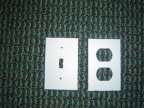While these are 2 things you will hardly ever hear about and probably won’t find them in any energy audit permanent furnace filters and foam insulation for electrical outlets are cheap easy additions to your environment. You will also notice that I have managed to discuss this whole topic of residential energy conservation withoutmentioning PAYBACK. The reason for that is I don’t believe in it. If you want to save energy/money, you will. If you do not then you won’t.
Professionals (gag and puke) will say rational sounding things like – Payback calculations allow consumers to prioritize their energy purchases. OR the equally obnoxious – If it takes more then 5 years to payback consumers won’t make the purchase. This is bullcrap, I know people who have wind turbines in their backyard. People who want to save WILL
Having said all that, both of these items payback are calculated in DAYS.
Electrostatic Furnace Filters

Air Filter’s Inc. Electrostatic Furnace Filters create its own electrostatic charge so it does not add to your electrical cost, but aids in reducing costs by keeping your air conditioning/ heating coils and equipment cleaner, so they operate at the highest capacity possible.Permanent washable electrostatic air filters are designed with a Heavy Duty Aluminum Frame, 2 Layers of special Polypropylene Weave on the front and back, with a unique poly internal lining designed for years of filtration.
:}
http://www.healthyhomefilterco.com/?gclid=COCGquzYi6ACFRHyDAod6j9SeQ
Our ELECTROSTATIC FURNACE FILTERS replace standard throw-away disposable air filters. Depending on where you live in the country, these filters are known as furnace filters, air conditioner filters or central air filters. They are PERMANENT, WASHABLE, REUSABLE and SELF-CHARGING. They have non-rusting ALUMINUM FRAMES and come with a LIFETIME WARRANTY.
These amazing filters reduce airborne dust in your house! Enjoy cleaner air and fewer allergy symptoms!
SAVE TIME…No need to search for that odd-sized a/c filter that nobody seems to carry.
SAVE MONEY…No need to buy a new furnace filter every few months. Pays for itself in about 1 year!
SAVE THE ENVIRONMENT…No need to fill up landfills with non-biodegradable fiberglass disposable filters.
We feature 5-Stage BoAir brand and 3-Stage Air Care brand permanent furnace filters. We pride ourselves on carrying the best air filters for the best price. Join our thousands of happy customers and switch to an electrostatic furnace filter today!
100% Satisfaction Guaranteed!
:}
http://www.neverbuyanotherfilter.com/?gclid=CMbP4rLZi6ACFRDxDAody3DMdw
OUR ELECTROSTATIC FILTERS ARE PERMANENT, WASHABLE, METAL-FRAMED WITH A LIFETIME WARRANTY.
* Replaces your furnace and/or air conditioning filters.
* Will work with all central heat and a/c systems.
Reduce dust in your house!
Enjoy cleaner air and less allergies!
Tired of forgetting to buy that pesky furnace filter every 3 months?
Tired of looking for that odd-sized filter that no one seems to stock? Stop wasting your time and money on ineffective disposable air filters. We offer permanent, metal-framed washable electrostatic filters from Air Care and BoAir. Never buy another filter again!
Our Electrostatic Filters Feature:
High Dust Arrestance…
Low Air Resistance.
Just vacuum off or hose off every 1-3 months and re-install.
Lifetime Warranty. 95% arrestance. Available in 41 standard sizes and custom sizes. Available in metal frame, deluxe frame and flexible frame (great for mobile home furnaces).
These same electrostatic filters retail elsewhere for $79.99-$99.99…
Get them at neverbuyanotherfilter.com for 50% OFF!
:}
Foam behind your electrical outlets? What is up with that. Well everytime I go into a house the first question I ask is, “do you have any holes in your wall?” They always laugh and say no. I take out a screw driver, take off a plug cover and say, “what do you call that?
http://www.homeadditionplus.com/insulation-info/Electrical-Outlet-Switch-Sealers.htm

Photo by – Mark Donovan
Electrical Outlets and switches located on exterior walls are frequently found to be major sources for cold air drafts. Left unchecked you can waste a lot of money on winter home heating energy bills. By installing electrical outlet and switch sealers you can prevent this from happening.
Electrical outlet and switch sealers are thin foam pads that have cutouts for the outlet and switch receptacles. They are very inexpensive and extremely easy to install.
|
||
:}
http://www.ehow.com/how_2383791_insulate-electrical-outlets.html
Heating or cooling a house seems to get a bigger piece of the family budget every month. Sealing the air loss around the home is critical and one of the often forgotten leaks is the electrical and light outlets that reside on the exterior walls of the home. A simple and inexpensive fix performed by anyone with a screwdriver and an hour to spare can save you money
:}
Anybody can change a filter or use a screw driver.
:}




















 In addition to being an energy saver, fiber glass insulation also acts as a sound absorber. When installed in walls and ceilings, it can reduce the transmission of sound from one room to another or from the outside. In today’s noise-laden environments, more and more homeowners are soundproofing their homes.
In addition to being an energy saver, fiber glass insulation also acts as a sound absorber. When installed in walls and ceilings, it can reduce the transmission of sound from one room to another or from the outside. In today’s noise-laden environments, more and more homeowners are soundproofing their homes. Insulation is identified and labeled by R-value. “R” stands for resistance to heat flow. The higher the R-value, the greater the insulating power. Manufacturers of insulation products print R-values of their products either on the bags or on the labels. In most cases, R-values are also printed on the facings of fiber glass batts and rolls.
Insulation is identified and labeled by R-value. “R” stands for resistance to heat flow. The higher the R-value, the greater the insulating power. Manufacturers of insulation products print R-values of their products either on the bags or on the labels. In most cases, R-values are also printed on the facings of fiber glass batts and rolls.



